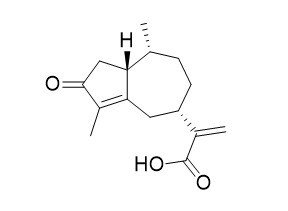Rupestonic acid
Rupestonic acid derivatives have an anti-influenza virus activity, they inhibit IAV by up-regulating HO-1-mediated IFN response.
Inquire / Order:
manager@chemfaces.com
Technical Inquiries:
service@chemfaces.com
Tel:
+86-27-84237783
Fax:
+86-27-84254680
Address:
1 Building, No. 83, CheCheng Rd., Wuhan Economic and Technological Development Zone, Wuhan, Hubei 430056, PRC
Providing storage is as stated on the product vial and the vial is kept tightly sealed, the product can be stored for up to
24 months(2-8C).
Wherever possible, you should prepare and use solutions on the same day. However, if you need to make up stock solutions in advance, we recommend that you store the solution as aliquots in tightly sealed vials at -20C. Generally, these will be useable for up to two weeks. Before use, and prior to opening the vial we recommend that you allow your product to equilibrate to room temperature for at least 1 hour.
Need more advice on solubility, usage and handling? Please email to: service@chemfaces.com
The packaging of the product may have turned upside down during transportation, resulting in the natural compounds adhering to the neck or cap of the vial. take the vial out of its packaging and gently shake to let the compounds fall to the bottom of the vial. for liquid products, centrifuge at 200-500 RPM to gather the liquid at the bottom of the vial. try to avoid loss or contamination during handling.
Bull. Pharm. Sci., Assiut University2020, 43(2):149-155.
Asian Journal of Chemistry2014, 26(8):2425
Environ Toxicol.2023, tox.23999.
J Pharm Biomed Anal.2022, 207:114398.
Plants (Basel).2023, 12(1):163.
Molecules.2024, 29(6):1392.
FEBS J.2022, 10.1111:febs.16676.
LWT-Food Sci Technol2020, 109163
Pharmacognosy Magazine2024, 20(2):632-645.
Int Immunopharmacol.2024, 143(Pt 2):113486.
Related and Featured Products
Free Radic Biol Med. 2016 Jul;96:347-61.
Rupestonic acid derivative YZH-106 suppresses influenza virus replication by activation of heme oxygenase-1-mediated interferon response.[Pubmed:
27107768 ]
Given the limitation of available antiviral drugs and vaccines, there remains to be a pressing need for novel anti-influenza drugs. Rupestonic acid derivatives were reported to have an anti-influenza virus activity, but their mechanism remains to be elucidated.
METHODS AND RESULTS:
Herein, we aim to evaluate the antiviral activity of YZH-106, a Rupestonic acid derivative, against a broad-spectrum of influenza viruses and to dissect its antiviral mechanisms. Our results demonstrated that YZH-106 exhibited a broad-spectrum antiviral activity against influenza viruses, including drug-resistant strains in vitro. Furthermore, YZH-106 provided partial protection of the mice to Influenza A virus (IAV) infection, as judged by decreased viral load in lungs, improved lung pathology, reduced body weight loss and partial survival benefits. Mechanistically, YZH-106 induced p38 MAPK and ERK1/2 phosphorylation, which led to the activation of erythroid 2-related factor 2 (Nrf2) that up-regulated heme oxygenase-1 (HO-1) expression in addition to other genes. HO-1 inhibited IAV replication by activation of type I IFN expression and subsequent induction of IFN-stimulated genes (ISGs), possibly in a HO-1 enzymatic activity-independent manner.
CONCLUSIONS:
These results suggest that YZH-106 inhibits IAV by up-regulating HO-1-mediated IFN response. HO-1 is thus a promising host target for antiviral therapeutics against influenza and other viral infectious diseases.
Bioorg Med Chem Lett. 2014 Sep 1;24(17):4318-22.
Rupestonic acids B-G, NO inhibitory sesquiterpenoids from Artemisia rupestris.[Pubmed:
25127164 ]
METHODS AND RESULTS:
Six new guaiane sesquiterpenoids, Rupestonic acids B-G (1-6), have been isolated from the whole plants of Artemisia rupestris together with six known compounds (7-12). The structures of the new isolates (1-6) were elucidated on the basis of extensive 1D and 2D NMR analysis, and the absolute configurations were established by electronic circular dichroism (ECD) in combination with density functional theory calculations.
CONCLUSIONS:
In in vitro bioassays, compounds 2 and 6 exhibited significant inhibitory effects on LPS-stimulated NO production in BV-2 microglial cells with IC50 values of 2.6 and 2.2 μM, respectively.
Phytochem Anal. 2010 Mar-Apr;21(2):205-9.
One-step separation and purification of rupestonic acid and chrysosptertin B from Artemisia rupestris L. by high-speed counter-current chromatography.[Pubmed:
19821258]
Artemisia rupestris L. is a well-known traditional Chinese medicinal plant in Xinjiang. Rupestonic acid is the main active ingredient of A. rupestris L., and has been chosen as a 'marker compound' for the chemical evaluation or quality control of A. rupestris L. and its products. Although HSCCC separation method was developed before, the separation was performed with two steps using the same solvent system, which were time-consuming and waste of the solvents.
To develop a simple HSCCC method for the separation and purification of Rupestonic acid in a single run.
METHODS AND RESULTS:
The measurement of partition coefficient (K) was introduced to select the two-phase solvent system. The simple HSCCC method was established according to the selected solvent system for separation and purification of Rupestonic acid. The purity of target compound was test by HPLC and the structure was identified by MS, (1)H NMR and (13)C NMR.A total of 72.3 mg of Rupestonic acid and 53.5 mg of chrysosptertin B with over 95% purity were yielded from 500 mg extracts of Artemisia rupestris L. in one-step separation.
CONCLUSIONS:
The Rupestonic acid was separated in a single run by HSCCC.



